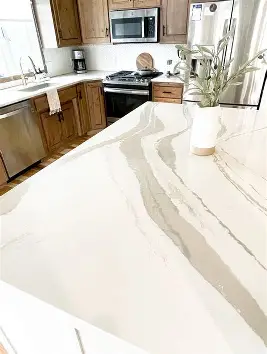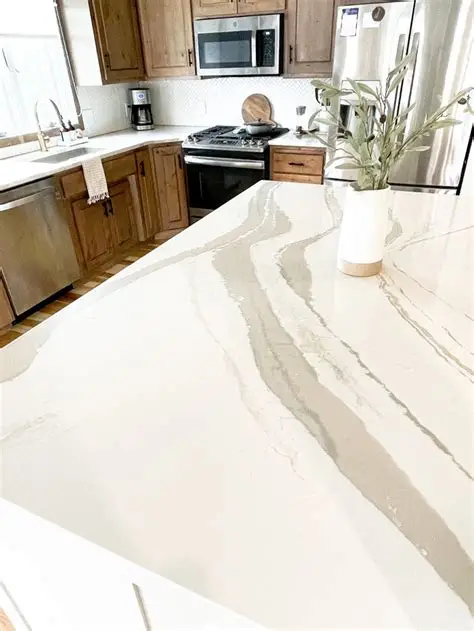Quartz countertops are a modern staple in homes, appreciated for their beauty, strength, and low-maintenance qualities. But have you ever asked yourself, “How do they make quartz countertops?” The answer is both fascinating and surprisingly technical.
Unlike natural stones like granite or marble, quartz countertops are engineered stone countertops, made by blending natural quartz crystals with resin and pigments to create a durable, non-porous surface. This process gives homeowners a vast array of styles to choose from—ranging from white quartz countertops to veined quartz countertops that resemble marble.
This guide will walk you through the complete manufacturing process, key features, benefits, and what makes quartz kitchen countertops and quartz bathroom countertops a favorite in contemporary design.
👉 Related: What Are Quartz Countertops?

The Composition of Quartz Countertops
At the heart of the process is natural quartz—one of the hardest minerals on Earth. To create quartz countertops, manufacturers use:
- 90–95% crushed natural quartz
- 5–10% polymer resins for binding
- Pigments for color
- Optional materials like mirror chips or recycled glass for added visual effects
This engineered mix allows for a controlled appearance and enhanced durability—something that natural stone can’t always guarantee.

Step-by-Step: How Quartz Countertops Are Made
1. Raw Quartz Sourcing and Crushing
Natural quartz is sourced from mines, then sorted and crushed into fine to coarse aggregates. The size of the quartz particles determines the appearance and texture of the final product. For example:
- Fine particles produce a smooth, uniform surface
- Larger pieces create more visual depth and veining
2. Mixing with Resins and Pigments
The crushed quartz is mixed with polymer resins and desired pigments. This step enables a vast selection of styles like:
- Calacatta quartz countertops (white with gray veining)
- Marble look quartz countertops
- Black quartz countertops for bold, modern kitchens
- Grey quartz countertops for neutral, balanced interiors
Some manufacturers add metallic flecks or glass chips to mimic natural stone sparkle or produce contemporary patterns.
3. Molding and Compaction
The resin-quartz mixture is poured into slab molds and compacted using vibrocompression vacuum technology. This advanced technique removes air pockets and evenly distributes the mixture, creating dense, durable quartz slabs for countertops.
The vacuum and vibration help ensure the slab’s structural integrity and resistance to cracking or chipping over time.
4. Curing the Slab
Once molded, the slab is placed in a kiln or industrial oven and cured at temperatures around 180–200°F (82–93°C). This process hardens the resin and locks the quartz particles in place.
The result is a slab that’s:
- Non-porous
- Heat-resistant (though not suitable for hot pans directly!)
- Incredibly hard and scratch-resistant
5. Polishing the Surface
After curing, the slabs are cooled and polished using diamond polishing heads, creating the signature shine of quartz countertops. Polishing stages vary from ultra-glossy to honed (matte) or even textured finishes.
Popular finishes include:
- Glossy for white quartz countertops
- Honed for marble-look
- Leathered for contemporary rustic vibes
6. Quality Inspection and Slab Trimming
Each slab undergoes rigorous quality control to check for:
- Color consistency
- Uniform thickness
- Absence of cracks or voids
After inspection, slabs are cut to standard sizes or customized dimensions for residential or commercial use.
💡 Tip: Always use proper Material-handling Equipment when lifting or transporting quartz slabs due to their weight and brittleness.
Quartz vs Granite Countertops: What’s the Difference?
Both quartz and granite countertops offer distinct advantages, but their differences begin at the source:
| Feature | Quartz Countertops | Granite Countertops |
|---|---|---|
| Material | Engineered | Natural stone |
| Maintenance | Low | Requires sealing |
| Porosity | Non-porous | Porous |
| Appearance | Consistent | Natural variations |
| Installation | Easier templating | More manual fitting |
👉 Compare more: Quartz vs. Granite Cost Comparison?
Pros and Cons of Quartz Countertops
✅ Pros:
- Non-porous and hygienic
- Resistant to stains, scratches, and heat
- No sealing required
- Available in many colors and styles
- Ideal for budget quartz countertops
❌ Cons:
- Not outdoor-friendly (UV can fade colors)
- Not safe for placing hot pans directly
- Higher quartz countertop installation cost compared to laminate or tile
👉 Learn about natural stone care: How to Seal Granite Countertops?
Are Quartz Countertops Worth It?
Definitely. Whether you’re investing in low maintenance quartz countertops for busy families or creating an upscale look with affordable white quartz countertops for modern kitchens, the value quartz offers is unmatched.
Their consistency and beauty make them ideal for:
- Best quartz countertops for kitchens
- Best types of quartz countertops for bathroom vanities
- Large islands and high-use areas
- Custom cutouts and edge profiles
Quartz Countertop Design and Installation
You can choose to purchase from:
- Local quartz countertop suppliers
- Quartz countertop showrooms
- Search “quartz countertops near me” or “quartz countertops in [city/region]”
After selection, slabs are templated, cut, and installed by professionals. You can also explore DIY quartz countertop installation tips, though it’s recommended only for experienced remodelers.
Final Thoughts
So, how do they make quartz countertops? Through a combination of advanced technology, natural minerals, and precise engineering. This hybrid approach produces a surface that’s beautiful, consistent, and built to last.
From engineered stone countertops to dramatic veined quartz countertops, the variety and performance of quartz make it a top choice in both modern and traditional homes.

